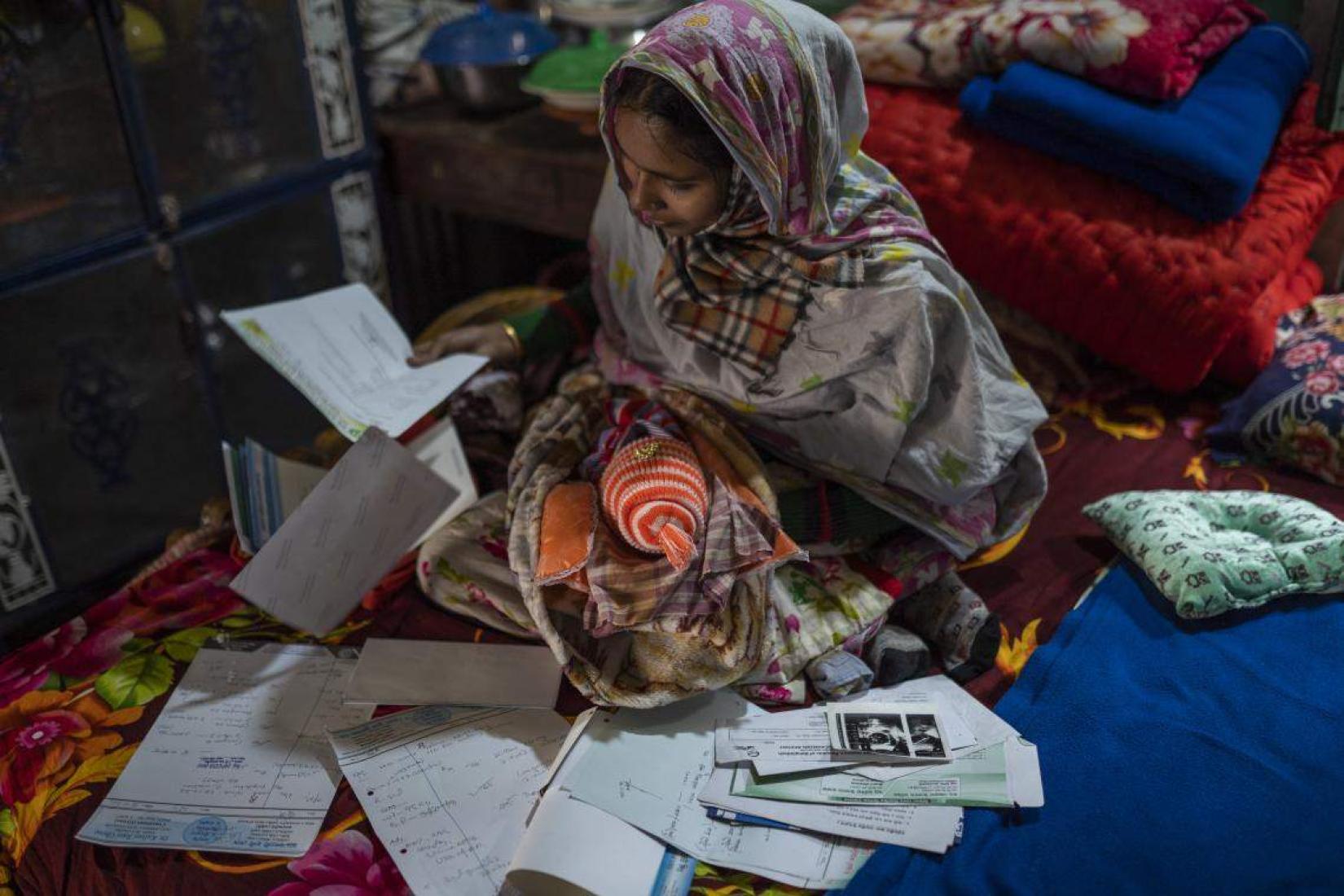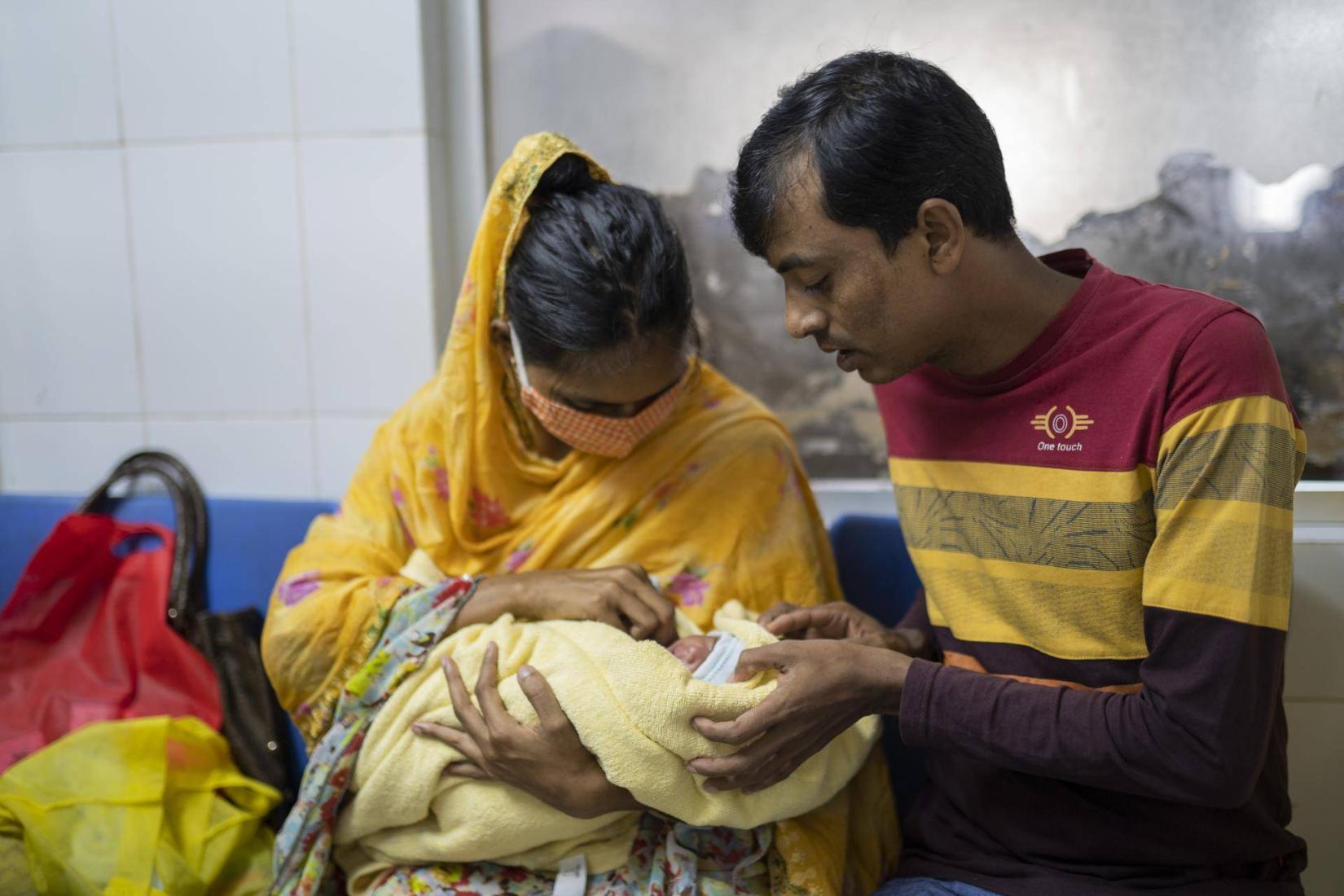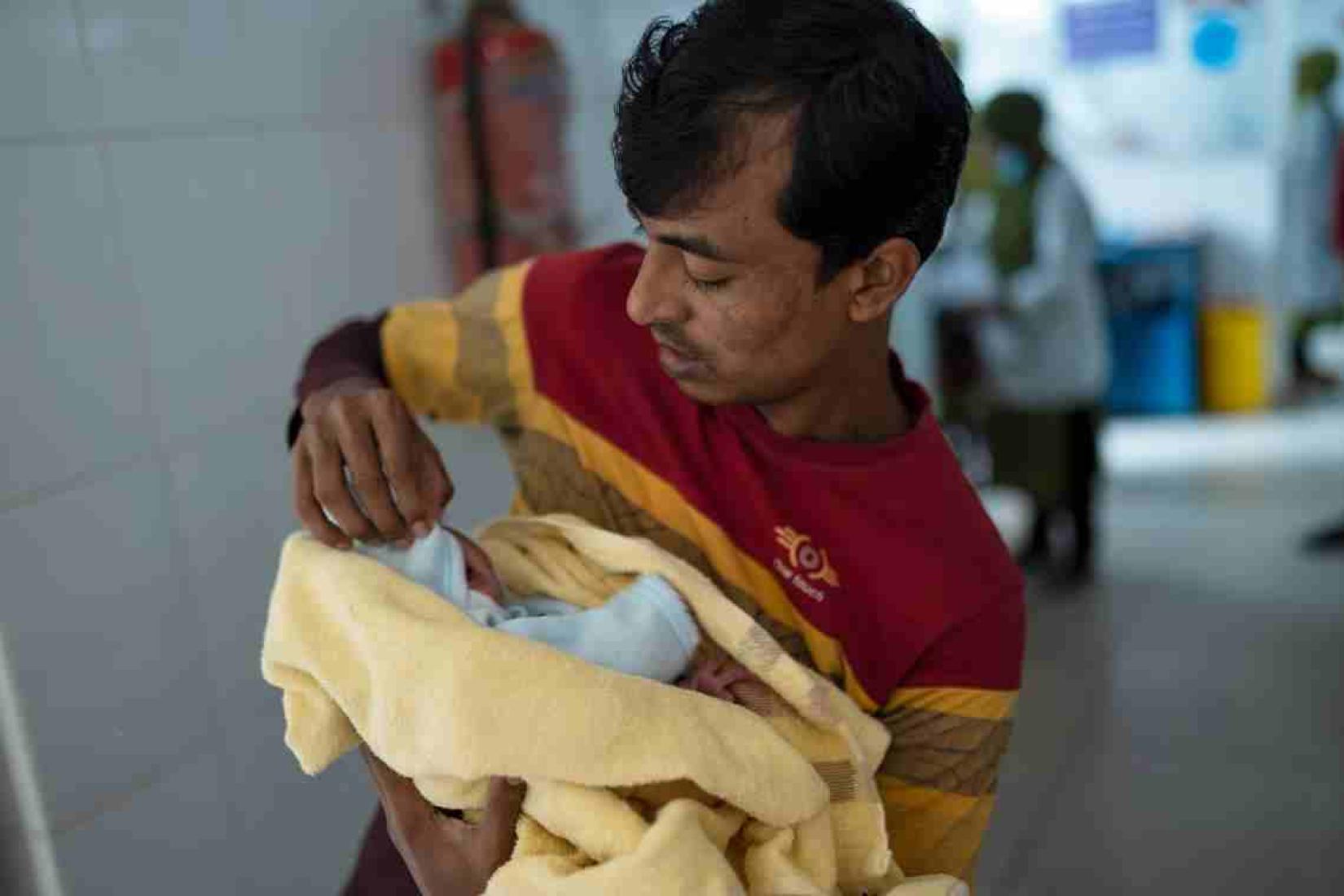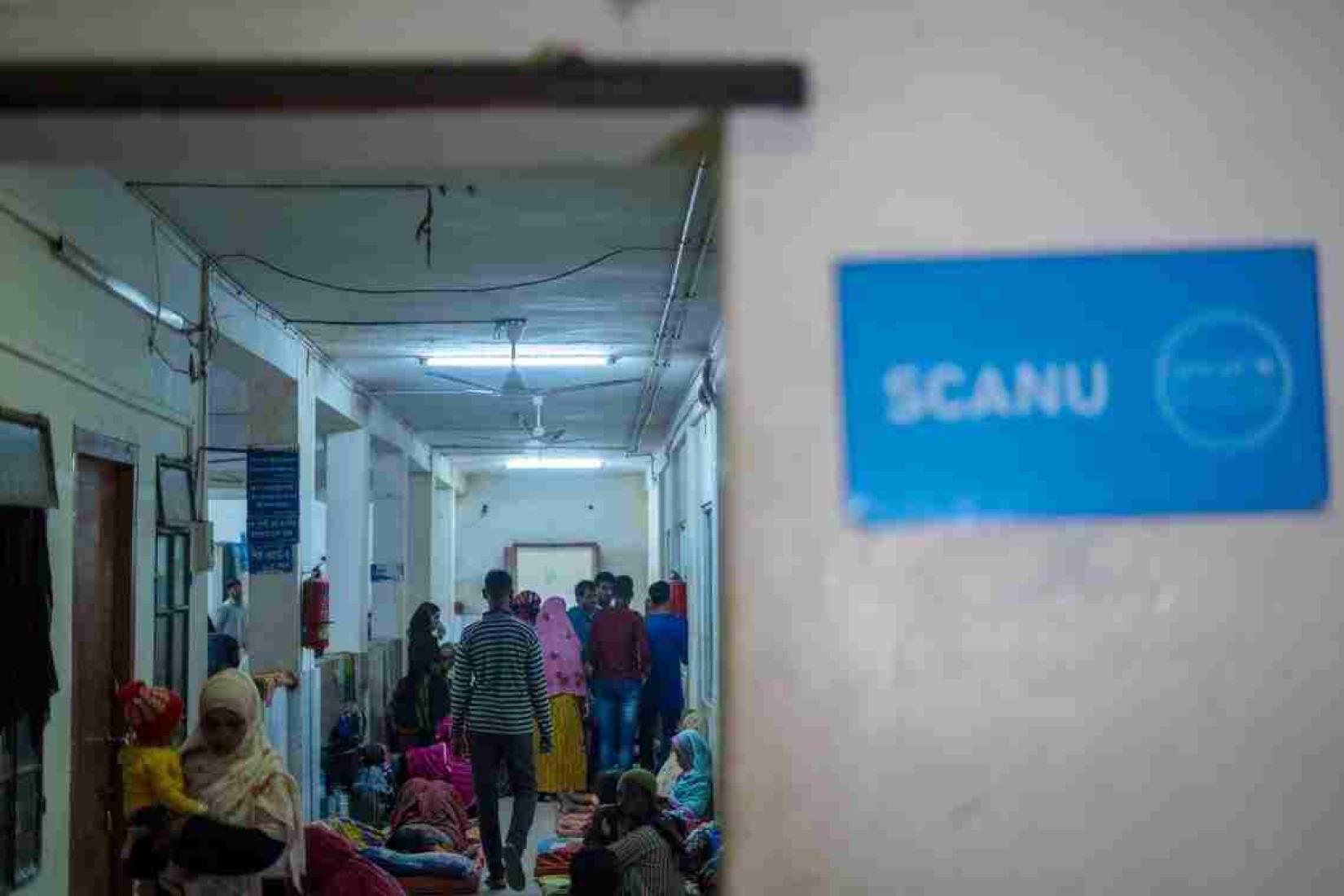A Family’s Journey from Heartache to Hope
Mymensingh, Bangladesh 23 November 2023
Admitted on time to the UNICEF-supported Special Care Newborn Unit, baby Rakiba survived premature birth complications.
Wearing a dark green hospital gown, Jui stood still and looked through the glass of the Special Care Newborn Unit (SCANU) in Netrokona District Hospital. Her anxious eyes followed every breath of her beloved baby, Rakiba. At only 18 days old, Rakiba was already a warrior fighting for air every second of her life.
Previously, Jui and her husband, Rafique, had already lost two babies due to complications during birth delivery. This time, they fortunately brought their daughter on time to Netrokona District Hospital, where the trained staff at the UNICEF-supported SCANU had the medical equipment to treat their daughter with quality care.

Lack of oxygen equipment
For months prior to Rakiba’s delivery, Jui and Rafique had waited for their baby to arrive in this world. They had traced fingers along the ultrasound images of Rakiba and kept them like treasure. They had dreamed about holding and protecting her with the love that they couldn’t give to their previous children. And yet now, that chance to love was once again slipping away as they watched Rakiba combat premature birth and severe hypoxemia1, a potentially deadly case of low blood oxygen.
“I didn’t have any complications while giving birth to Rakiba at a clinic. She also seemed fine and cried normally like all newborns,” recounted Jui. “But suddenly she started to have breathing problems. The nurses told me to take her to Netrokona hospital urgently.”
Living in rural Bangladesh, Jui had barely known quality, specialized care for mothers and newborns. And with a health condition that required immediate oxygen equipment at all times, her daughter was even less likely to survive.

The leading cause of deaths for children under five
Despite progress in Bangladesh, the mortality rate of children under five remains comparatively high, at 31 deaths per 1000 live births2. Newborn deaths are responsible for over 60 per cent of the deaths under five, with birth asphyxia and injury responsible for 29 per cent as the main cause. Pneumonia has also been the leading cause for under-five deaths for more than three decades, with hypoxemia present in about 13.3 per cent of severe cases.3
In addition, as found in a UNICEF-supported national assessment in 2020, 70 percent of medical facilities lacked adequate oxygen infrastructure and other essential oxygen equipment in the maternal, newborn and pediatric units.
“Previously we couldn’t give oxygen treatment to all newborns because we had limited number of oxygen cylinders,” remembered Dr. Moumita Sharmin, Medical Officer who worked in the UNICEF-supported newborn unit in the Netrokona District Hospital.

The leading cause of deaths for children under five
Despite progress in Bangladesh, the mortality rate of children under five remains comparatively high, at 31 deaths per 1000 live births2. Newborn deaths are responsible for over 60 per cent of the deaths under five, with birth asphyxia and injury responsible for 29 per cent as the main cause. Pneumonia has also been the leading cause for under-five deaths for more than three decades, with hypoxemia present in about 13.3 per cent of severe cases.3
In addition, as found in a UNICEF-supported national assessment in 2020, 70 percent of medical facilities lacked adequate oxygen infrastructure and other essential oxygen equipment in the maternal, newborn and pediatric units.
“Previously we couldn’t give oxygen treatment to all newborns because we had limited number of oxygen cylinders,” remembered Dr. Moumita Sharmin, Medical Officer who worked in the UNICEF-supported newborn unit in the Netrokona District Hospital.
A special care unit for babies
Across public hospitals in the country, UNICEF, along with partners, supported the Government in establishing SCANUs, where nurses and doctors treated low-birthweight and sick newborns like Rakiba. These units were equipped with UNICEF-supported medical equipment, including piped medical oxygen to SCANUs, oxygen concentrators, flowmeters, radiant warmers and resuscitators.
“The UNICEF-supported unit has been a blessing in this hospital,” said Dr. Sharmin. “Now we have oxygen support at every bed and can treat all newborns. We are able to serve such a large population in Netrokona thanks to adequate oxygen supply.”
To her parents’ overwhelming joy, Rakiba slowly got better and was discharged from the hospital. Swaddled in a yellow blanket in her mother’s arms, Rakiba breathed softly. As if afraid she would disappear, her father kept fixing her clothes to make sure she was warm.
"She received oxygen support immediately in the newborn unit,” recounted Jui.
Both parents then attentively listened to the doctor’s advice on how they should take care of Rakiba at home and when they could return for a check-up. Upon reaching home, Rafique picked up more housework to make sure that both his wife and daughter could rest and recuperate.
For all newborns, a healthy start in life
Outside the glass wall of the UNICEF-supported SCANU stood parents who were waiting with hope, longing to get a glimpse of their children. Inside, doctors and nurses were going from one incubator to the next, patiently checking on one baby after another.
Adequate access to oxygen had truly made a difference in the lives of medical staff, parents, and sick babies. Within three years, from the beginning of 2021 to the end of 2023, over 300,000 sick newborns in Bangladesh were admitted to the Special Care Newborn Units, and oxygen support had been sustained in all the health facilities. Health workers have been trained on rational use of oxygen, which is extremely important to avoid complications.
“The newborn mortality rate has dropped. The recovery rate is becoming faster,” said Dr. Moumita Sharmin. “We are able to serve such a large population in Netrokona thanks to adequate oxygen supply.”
----------------------------------------------
1 Hypoxemia is a condition where the oxygen saturation in the blood suddenly drops, posing a life-threatening risk caused by an underlying illness or injury. It is a common and potentially fatal complication of pneumonia and other Acute Respiratory Tract Infections among children under the age of five.
2 DHS 2022, preliminary report. The DHS Program - Bangladesh DHS 2022 - Key Indicators Report (English)



